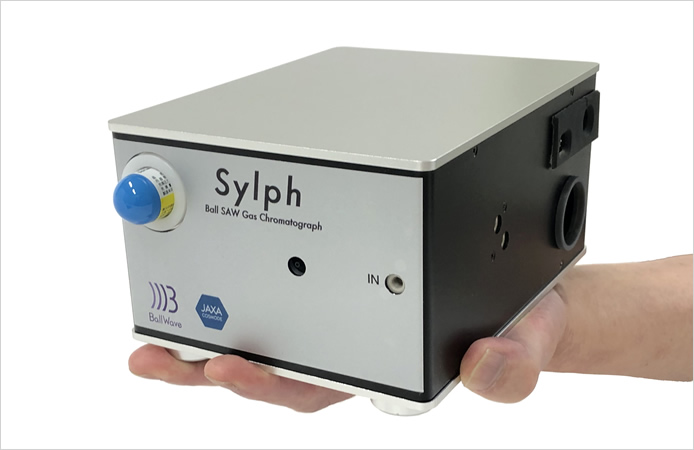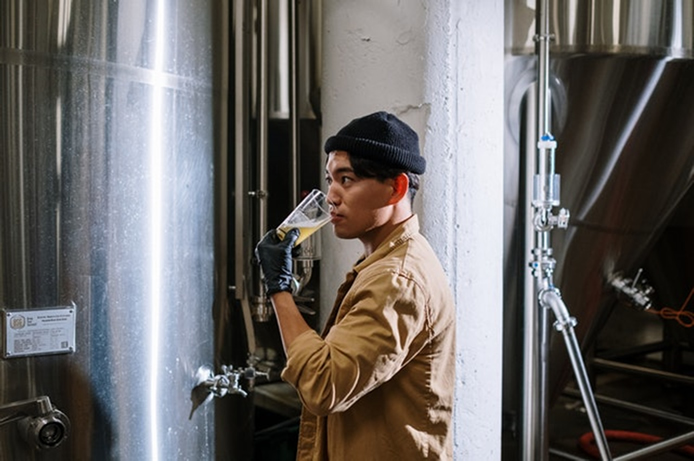Products
Ball Wave Inc.
- JP
- EN

Product 02
Palm-sized Gas Chromatograph SYLPH
Palm-sized gas analyzer that can be used in a wide variety of fields
About Palm-sized Gas Chromatograph

A gas chromatograph is an analyzer for measuring the species and concentration of a mixed gas of multiple species.
We successfully developed a gas chromatograph with dimensions of 100 × 100 × 100 mm and a weight of around 1 kg for space applications through the JAXA Space Exploration Innovation Hub Center by utilizing ball SAW sensor technology.
Furthermore, we developed a portable palm-sized (A5 size) gas chromatograph called Sylph for terrestrial applications, and started providing prototypes. We received “JAXA COSMODE” usage licensing from JAXA.
The basic principle used in Sylph is that the sample gas is directly sucked in by a pump, and is condensed by a built-in compact condenser. The carrier gas is provided by a hydrogen canister filled with a hydrogen absorbing alloy, and the mixed gas is injected into the column by a high-speed heater in the condenser. The various gas components separated by the column are detected by the ball SAW sensor based on the different retention times.
Structure of Palm-sized Gas Chromatograph
Palm-sized Gas Chromatograph SYLPH
Examples of Sylph measurements

| ① n-hexane (C6) | 185 ppmv |
|---|---|
| ② Benzene (B) | 50 ppmv |
| ③ n-heptane (C7) | 50 ppmv |
| ④ Toluene (T) | 30 ppmv |
| ⑤ n-octane (C8) | 20 ppmv |
| ⑥ Ethylbenzene (E) | 20 ppmv |
| ⑦ m-xylene (X) | 20 ppmv |
| ⑧ n-nonane (C9) | 10 ppmv |
Specifications of palm-sized gas chromatograph
| Main body | Model name | SY-402 |
|---|---|---|
| Size | W133mm×H88mm×D174mm(Protrusions not included) | |
| Weight | 1.9kg | |
| Power Requirements | DC24V (port 5.5×2.1mm) ※AC adaptor100~240VAC、50/60Hz included) | |
| Power Consumption | Max. 72W | |
| Connection | USB | |
| Environment | 10℃~40℃、with no water condensation | |
| Gas inlet | Connector: 10-32 coned | |
| Gas outlet | Connector: 10-32 coned、Smell-sniffing nose patch connectable(Option) | |
| Control | PC | Surface Pro 8、Windows 11 |
| Operation | Built-in control program | |
| Start-up time | Within 10 min after launching operation(including backflush) | |
| Shut-down time | Within 5 min after stop operation | |
| Data output | CSV file format | |
| Carrier gas | Type of gas | Hydrogen1) |
| Flow rate | 1ml / min | |
| Supply method | Hydrogen storage alloy canister2,3) | |
| Capacity | 6L | |
| Estimated time of use | 100 hours / canister | |
| Concentrator | Adsorbent | Choice from TenaxRTA or Tenax TA+CarboxenR1000 |
| Captured volume | 1~1000ml、programmable | |
| Injection temperature | Up to 240℃ | |
| Cleaning | Automatic at start-up and after measurement | |
| Column | Stationary layer | Choice from High polarity, Mid polarity or Low polarity type4) |
| Temperature range | 40℃~200℃ | |
| Hearing rate | Max. 20℃ / min、programmable | |
| Cooling rate | Within 5 min from 200℃ to 50℃ | |
| Cleaning | With backflush feature | |
| Detector | detector | Ball SAW sensor |
| Sensing film | Polydimethylsiloxane | |
| Operating frequency | 150MHz |
- Carrier gas can be changed by a cylinder adapter (optional).
- For filling hydrogen to a canister, please prepare a hydrogen cylinder or a hydrogen generator at the customer.
- Long-term usage can cause binder components inside the canister to be detected. We recommend replacing it after about 1 year of use.
- Column types shown in the table below are available as standard products. If you would like to request a different type of co lumn, please contact us.
| Type | Stationary Phase | Length (m) | Bore (mm) | Film thickness (μm) | Applications |
|---|---|---|---|---|---|
| High polarity | Polyethylene glycol (PEG20M) | 30 | 0.25 | 0.25 | General analysis、Ester、Perfume、Alcohol、Aromatic |
| Mid polarity | 6%Cyanopropylphenyl ? 94%polydimethylsiloxiane | 30 | 0.25 | 1.0 | VOC、Alcohol analysis |
| Low polarity | 5%diphenyl - 95%polydimethylsiloxane | 30 | 0.25 | 0.5 | General analysis、Halogen compounds、Phenol |
Applications of palm-sized gas chromatograph
The palm-sized gas chromatograph can be used in a wide variety of fields including energy, industry, agriculture, forestry, fisheries, and healthcare, and is expected to contribute to achieving a safe, secure, and clean sustainable society.
Early detection of freshness and degradation of fresh foods, food oils, etc.
Fermentation process monitoring for Japanese sake, soy sauce, etc.
Detection of gasses associated with sick house syndrome and pollution in soil
Disease discovery by analysis of exhaled air, body odor, and intestinal gases
Gas component analysis in cutting-edge manufacturing processes
Screening for harmful gases and abnormal odors in the environment

